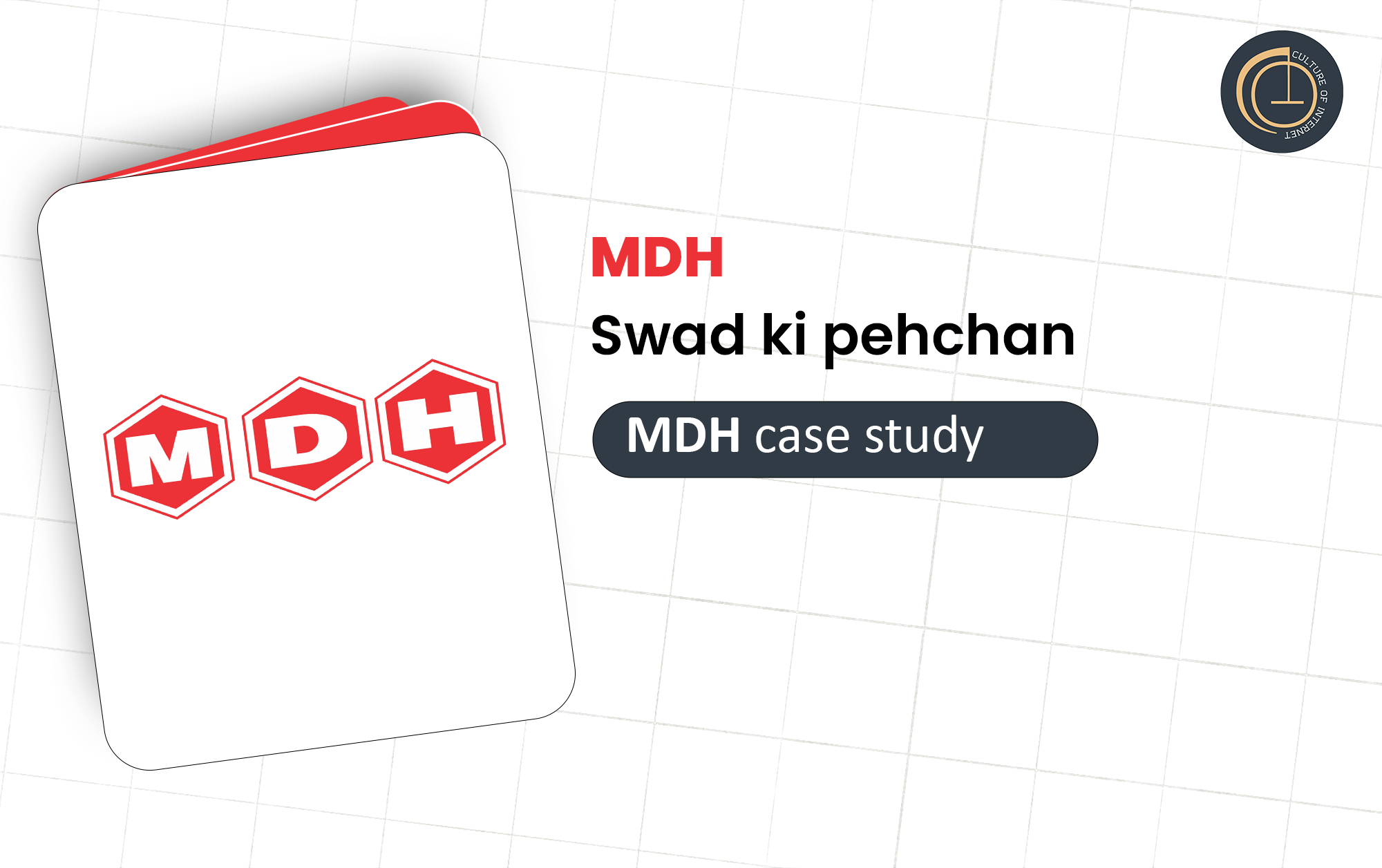A Story of spice & struggle
MDH, the famous name we all recognize on spice boxes today, had a very simple and inspiring beginning.
It all started back in 1919 in Sialkot, a city that is now in Pakistan. A man named Mahashay Chunnilal Gulati opened a small shop called Mahashian Di Hatti. He used to sell pure, hand-ground spices that people loved for their strong aroma and quality.
But everything changed in 1947, when the Partition happened. His son, Mahashay Dharampal Gulati, had to leave everything behind and move to India. He came to Delhi with just ₹150 in his pocket. Out of that, he spent ₹35 to buy a tonga (a horse cart) and started earning a little money by giving rides.
Even after so much struggle, he didn’t give up. He used the rest of the money to restart his spice business in Delhi. Slowly, with honesty, hard work, and belief in quality, he turned that small effort into a big success. That small spice shop grew into MDH, one of India’s most trusted and loved brands.
Today, MDH is not just a name—it’s a part of every Indian kitchen, all thanks to one man’s courage and determination.
The Story Behind MDH
-
MDH isn’t just a brand sitting on a supermarket shelf. It’s that familiar red box in your kitchen, the aroma in your favorite curry, and a name that feels like home. But behind it lies a story of grit, hope, and pure determination.
-
It all began back in 1919, in Sialkot (now in Pakistan), when a man named Mahashay Chunnilal Gulati opened a small spice shop. He called it Mahashian Di Hatti, meaning “shop of a respectable man.” The shop quickly gained love for its freshly ground masalas and honest flavor.
-
Then came the partition of India in 1947 — a moment that changed everything.
-
His son, Mahashay Dharampal Gulati, left everything behind and came to India as a refugee. He arrived in Delhi with barely ₹1,500 in his pocket. Out of that, he spent ₹650 to buy a tonga (a horse cart) and started ferrying passengers to make ends meet.
-
TBut his heart was still in spices.
-
Soon, he sold the tonga and rented a small shop in Karol Bagh. With sheer hard work, he started selling spices again, slowly rebuilding what his family had lost. People started noticing the quality. Word spread. The small shop turned into a factory, and MDH was born anew.
-
Over the years, MDH became one of the most trusted spice brands in India — not just for its products, but for the man behind it. You’ve probably seen him too — the smiling elderly man with a
-
turban on every MDH box? That’s Mahashay Dharampal Gulati himself.
-
He wasn’t just the face of the brand; he was its soul. Even after becoming a billionaire, he lived a simple life and was deeply involved in charity work — building hospitals, schools, and helping those in need.
In 2020, the nation mourned his passing, but his legacy lives on — in every kitchen, every masala dabba, and every dish that tastes just a little better with MDH.
A Legacy That Lives on
-
MDH, one of India’s most iconic spice brands, continues to hold a strong and respected place in Indian households. After the passing of the beloved face of the brand, Dharampal Gulati (fondly known as Dadaji) in 2020, the company has been led by his son Rajeev Gulati. Under his leadership, MDH has maintained its trusted image and continues to thrive in the competitive spice market.
-
Even today, you’ll find MDH products in almost every Indian kitchen—from turmeric and red chilli powder to their famous blends like Chana Masala and Kitchen King. Their wide distribution network, strong brand loyalty, and reputation for quality have helped them retain a solid position despite newer brands entering the market.
-
MDH isn’t just a spice company—it’s a part of Indian culinary tradition. And with the Gulati family's continued involvement, the brand seems committed to staying true to its legacy while keeping pace with modern market demands.
Journey From Masalas to Millionaire of Kitchens
MDH (Mahashian Di Hatti) isn’t just a spice brand anymore – it’s an emotion in Indian kitchens. Over the years, MDH has smartly diversified its products and presence, going beyond traditional ground spices and adapting to modern tastes and global markets.
From Simple Spices to Signature Blends
What started with basic masalas like turmeric, chili, and coriander soon grew into a rich lineup of spice blends for almost every Indian dish you can think of – from Chana Masala and Garam Masala to Kitchen King and Shahi Paneer Masala. MDH realized early on that Indian cooking isn’t one-size-fits-all, so they created special blends to suit regional flavors and recipes.
Modernizing the Backend
To meet rising demand, MDH invested in large-scale manufacturing units equipped with the latest technology. Their plants ensure hygiene, consistency, and fast production – so whether you’re buying MDH in Delhi or Dubai, the taste stays the same.
Stepping into Global Kitchens
MDH didn’t just stay limited to India. It expanded across continents, reaching over 100 countries. For many Indians living abroad, spotting that familiar MDH pack in a supermarket brings a taste of home.
Ready for the Modern Cook
As cooking habits changed, MDH adapted. They launched ready-to-use spice mixes, catering to young, busy professionals who want homemade flavors without spending hours in the kitchen.
Spreading Spice Through Smart Partnership
MDH has always stood tall as a proudly Indian brand, but that doesn't mean it’s walked the path alone. While it built its identity through tradition and trust, MDH has also formed some clever collaborations over time to keep up with changing trends and reach more kitchens — in India and around the world.
Retail & Online Platforms
MDH teamed up with leading supermarket chains like D-Mart, Reliance Fresh, and Big Bazaar, making sure its products are always within reach of Indian shoppers. As online shopping grew, MDH didn’t sit back — it joined hands with Amazon, Flipkart, BigBasket, and Blinkit, bringing its masalas right to people’s doorsteps.
Taking Indian Flavor Global
To make its way into international kitchens, MDH partnered with export companies and Indian food distributors across the US, UK, Canada, UAE, and more. These collaborations helped the brand tweak packaging, meet global food standards, and connect with the Indian diaspora craving authentic taste abroad.
Digital Influence & Cultural Events
In recent years, MDH has begun appearing in food vlogs, recipe videos, and influencer content online. While the brand was once known for its classic TV ads with the iconic “MDH wale uncle,” it now connects with younger audiences through Instagram reels and YouTube chefs. It has also supported culinary events and local food festivals, subtly reminding everyone that real flavor starts with real spices.
Marketing Strategies of MDH-Old School Charm with Timeless Impact
MDH didn’t need a million-dollar celebrity or fancy ad campaigns to win hearts — it used something far more powerful: trust, consistency, and a deep connection with Indian households.
The Face of the Brand – Mahashay Dharampal Gulati
For years, MDH’s marketing revolved around its founder. The smiling face of “MDH wale uncle” became iconic — not just because he was the owner, but because people trusted him. Seeing him on TV or packaging felt personal, like a guarantee of quality from someone you knew.
Simple Yet Memorable Advertisements
Who can forget the classic MDH jingle?
“MDH... MDH... MDH!”
Their ads didn’t try to be over the top — they stuck to simple messaging, focused on home-cooked food, and always ended with a warm smile. That nostalgia still works even today.
Strong Packaging & Visibility
MDH spices have a consistent and instantly recognizable look — bold red, clear labels, and the founder’s photo. Whether you’re in a small kirana store or a supermarket abroad, MDH stands out on the shelf.
Expansion to Online & Global Markets
As times changed, so did MDH. It partnered with platforms like Amazon, Flipkart, and BigBasket, making sure even the digital generation could get its hands on their favorite masalas. Internationally, MDH made its way into over 100 countries, focusing on Indian communities and global food lovers.
Word-of-Mouth & Legacy Trust
MDH didn't rely heavily on influencers or trending hashtags — it built loyalty over generations. People recommend MDH not because of ads, but because their mom, grandmother, or neighbor swears by it. That kind of marketing is priceless.
Backbone Behind the Spice Empire
MDH isn’t just about spices – it’s about the network behind the scenes that makes those little packets of flavor reach every corner of India and even beyond. Over the years, MDH has built a powerful web of connections, from farmers to factories, shopkeepers to global markets.
Strong Bond with Farmers & Suppliers
At the heart of MDH’s network are the farmers. The brand sources its raw spices like red chilies, coriander, turmeric, and cumin from trusted regions across India — Rajasthan, Kerala, Gujarat, and beyond.
Instead of chasing short-term deals, MDH has built long-term, reliable relationships with suppliers to ensure purity, consistency, and fair trade.
A Solid Internal Network
MDH owns several manufacturing plants, mainly in Delhi and surrounding areas. These facilities are fully equipped — grinding, blending, testing, and packaging all happen in-house. This tight-knit system means better control over quality and faster turnaround times.
Deep-Rooted Retail Connections
MDH spices are everywhere — from small local kirana shops to big retail chains. That’s because over the years, MDH has nurtured a vast distribution network across India. Distributors, stockists, and shopkeepers have strong ties with the brand, making sure those red MDH boxes are always on the shelves.
Global Presence Through Export Partners
Outside India, MDH has linked up with food exporters and Indian grocery distributors across more than 100 countries. Whether it’s London, New York, or Dubai — you’ll find MDH on the shelf, thanks to their smart global networking.
Explore Our Comprehensive Marketing Strategy Course
Join our in-depth course to master MDH India's marketing strategies, learn from expert case studies, and gain actionable insights to apply in your own business or career.









